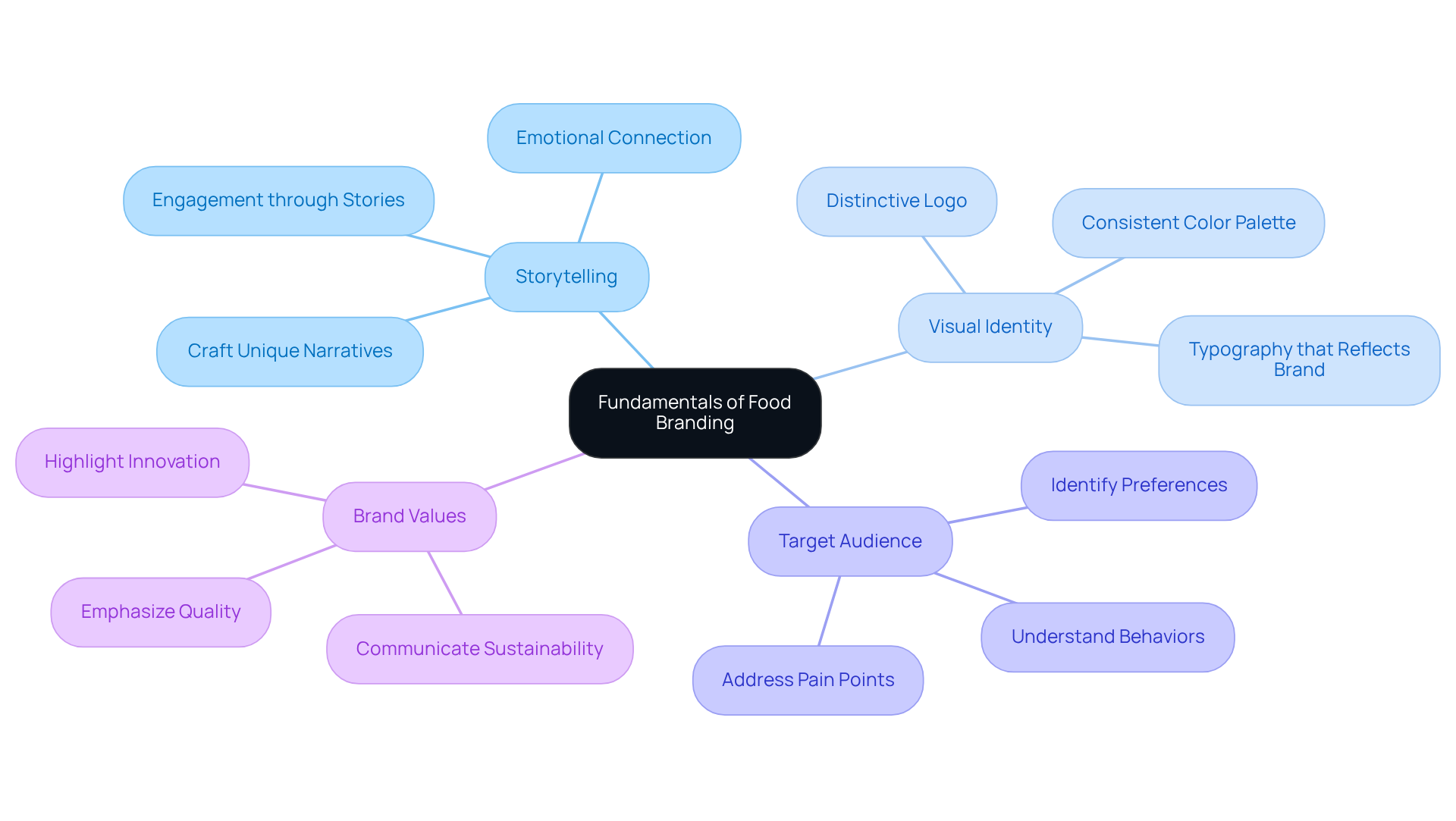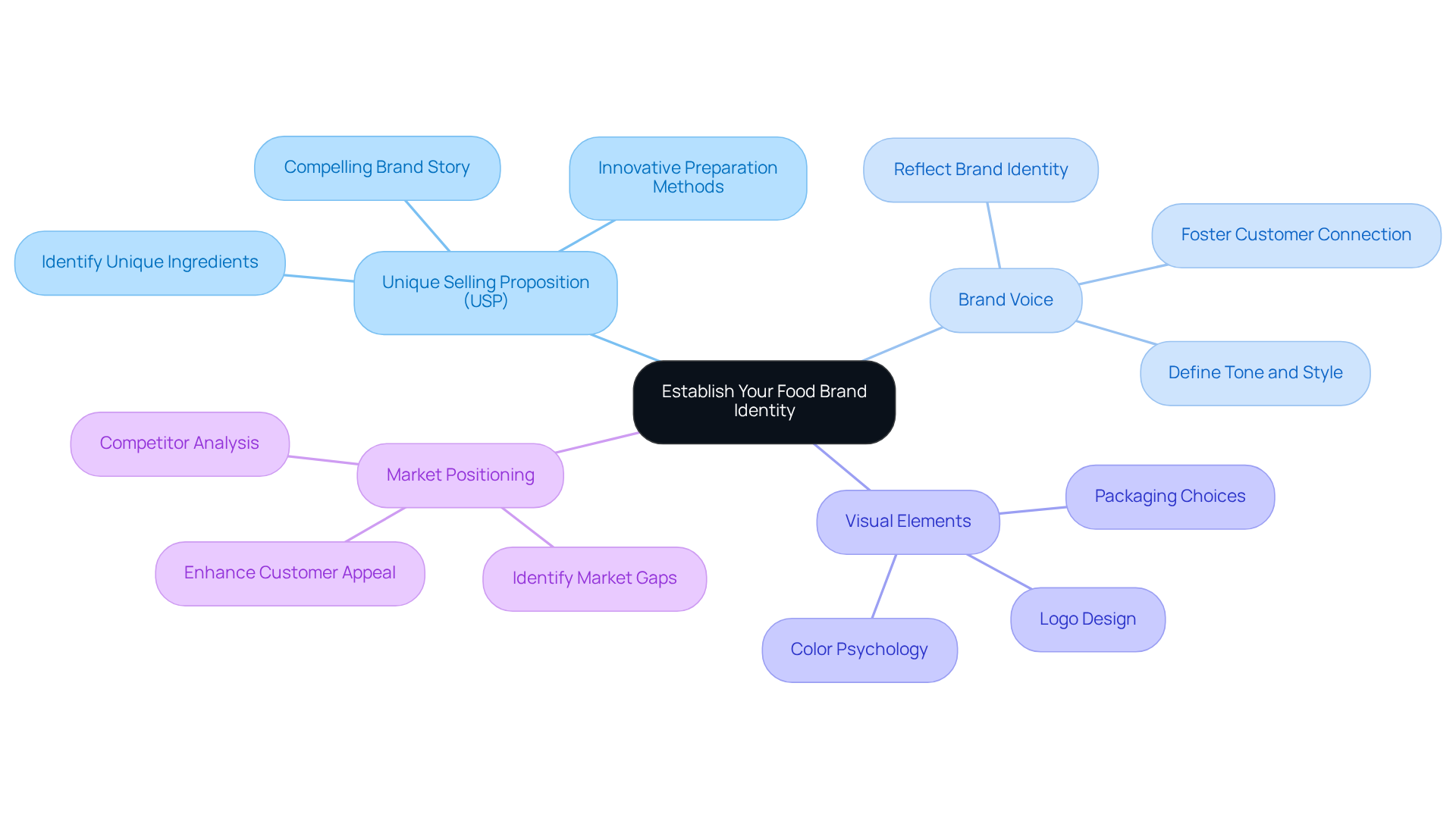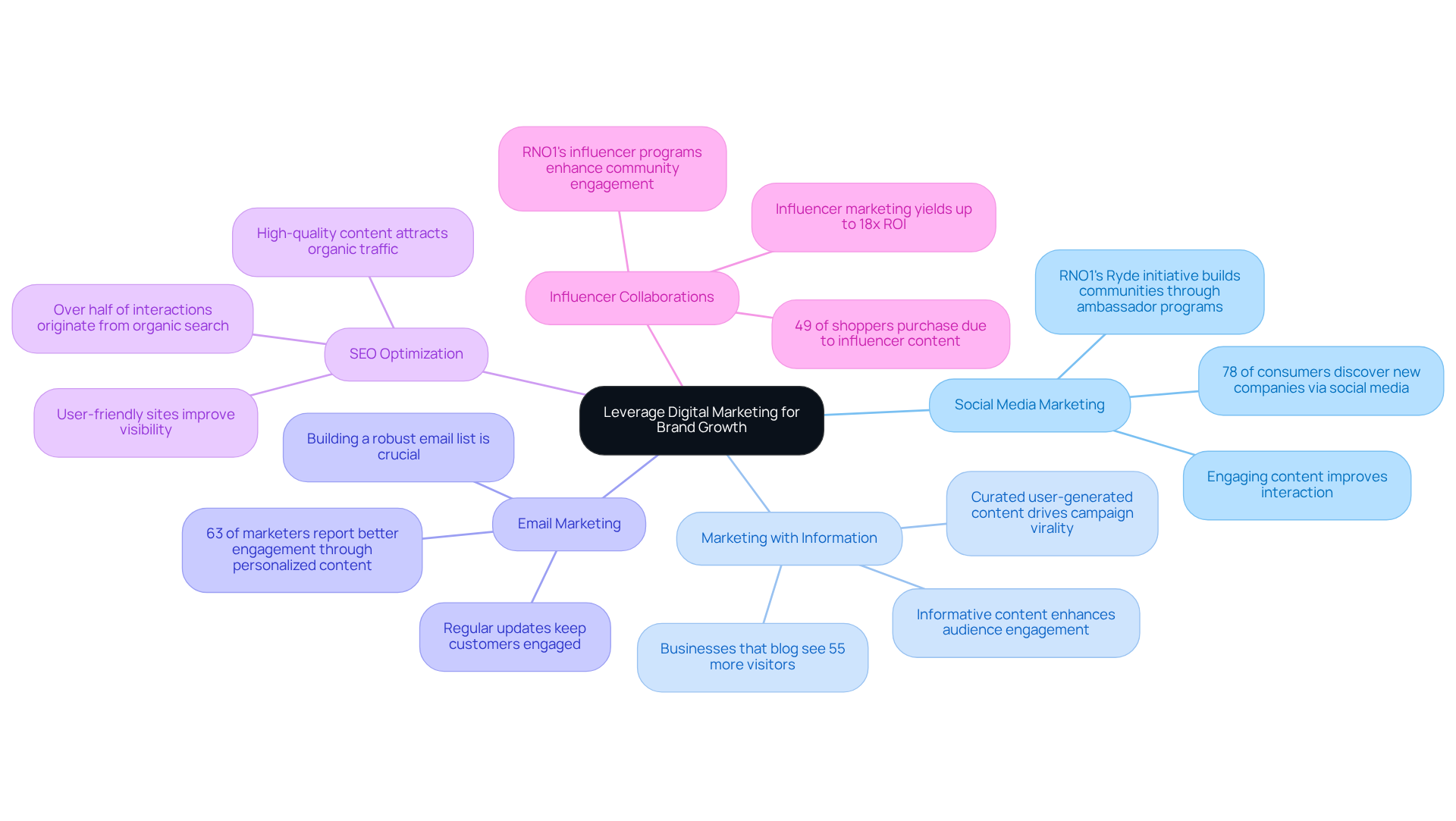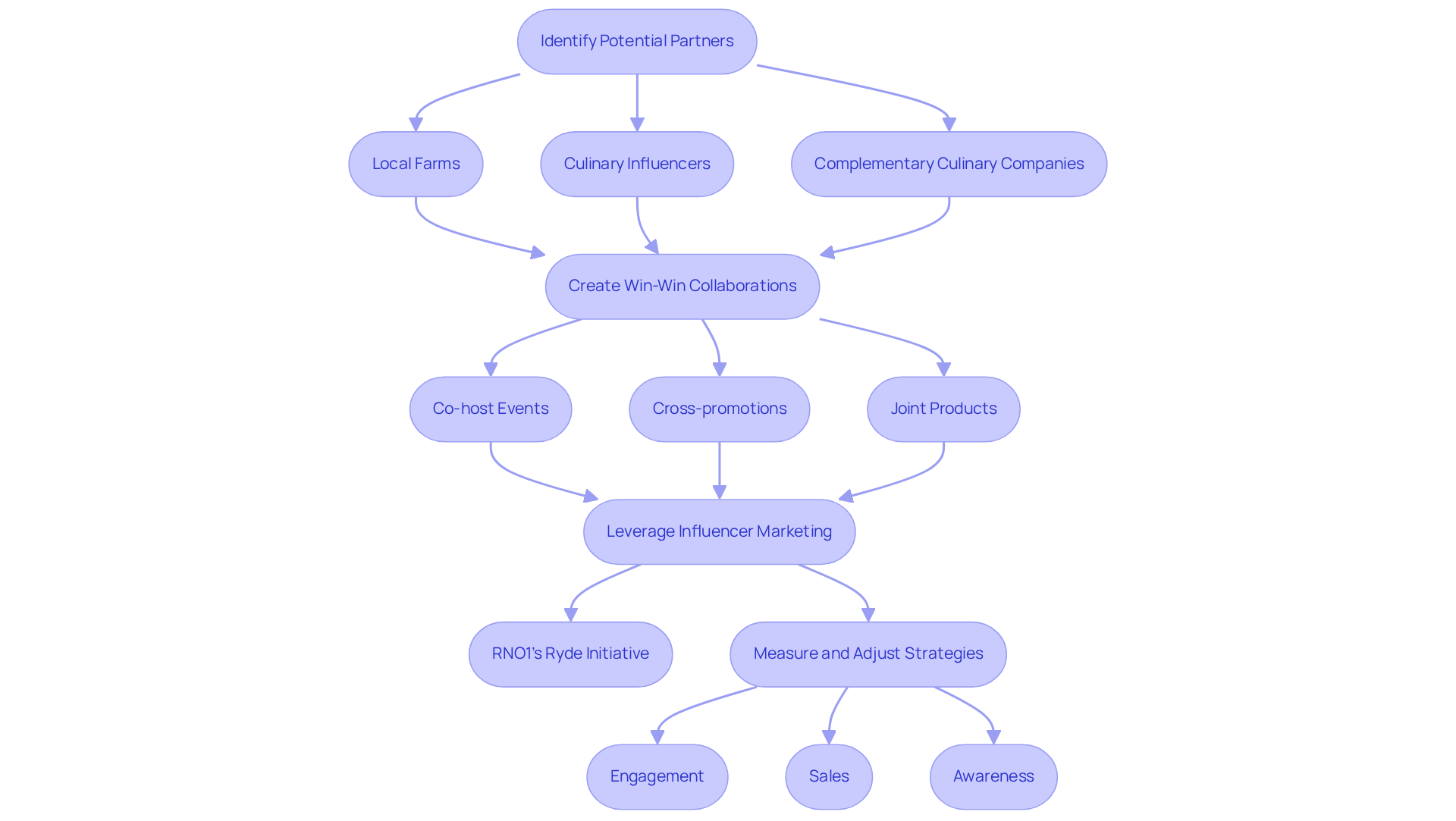Overview
Mastering food branding can feel overwhelming, as it requires creating a compelling identity through storytelling, visual elements, and a deep understanding of the target audience. This complexity often leaves many feeling uncertain about how to drive customer loyalty and foster business growth.
It’s important to recognize that successful branding is not just about aesthetics; it requires a strategic approach. This includes:
- Defining a unique selling proposition
- Leveraging digital marketing
- Building meaningful partnerships that resonate with consumers in a competitive landscape
By embracing these strategies, you can cultivate deeper connections with your audience, ultimately leading to lasting loyalty and growth. Remember, you’re not alone in this journey; many have faced similar challenges and found success through thoughtful branding efforts.
Introduction
Branding in the food industry goes beyond just logos or packaging; it tells a story that creates genuine connections with consumers. As culinary brands face the challenges of a competitive environment, recognizing the essential elements of effective food branding is vital for fostering growth and loyalty.
Many brands struggle to stand out and truly resonate with their target audience in a crowded marketplace. This article explores the basics of food branding, providing insights and strategies designed to help businesses cultivate a strong identity and flourish in the digital age.
Together, we can navigate these complexities and find the path to success.
Understand the Fundamentals of Food Branding
is more than just logos or packaging; it’s about weaving a narrative that resonates deeply with buyers. Many brands struggle to connect meaningfully with their audience, which can lead to missed opportunities for loyalty and engagement. Here are some essential fundamentals that can help bridge that gap:
- Storytelling: Every brand has a unique story waiting to be told. By crafting a compelling narrative that reflects your company’s origins, mission, and values, you can foster an . As industry specialists emphasize, .
- Visual Identity: that embody your company’s personality is vital. Consistency in visual elements across all platforms not only enhances recognition but also strengthens the emotional ties individuals form with your organization. At RNO1, we believe that a is essential in creating a memorable visual identity that truly stands out.
- Target Audience: Understanding your target market is key. By identifying their preferences, behaviors, and pain points, you can tailor more effectively. Engaging with your audience on a personal level can lead to deeper connections and increased loyalty, creating a sense of community.
- Brand Values: Clearly articulating what your brand stands for is imperative. Whether emphasizing sustainability, quality, or innovation, these values must be communicated consistently to build trust with customers. A design-focused approach ensures that these values are visually represented in every aspect of your branding.
In the food industry, the profound power of storytelling and visual identity plays a crucial role in branding food. Successful campaigns, like KFC’s 'Suppertime Stories,' demonstrate how and cultivate deeper connections. By focusing on these fundamentals, companies can create a lasting impact and foster growth in an increasingly competitive landscape. Together, let’s explore how RNO1 can support you in this journey.

Establish Your Food Brand Identity and Positioning
To establish a strong and positioning for your branding food, it's important to consider some essential steps that can truly make a difference.
- Define Your : What makes your food brand special? It could be unique ingredients, innovative preparation methods, or a captivating story that resonates with your consumers. Recognizing this uniqueness is crucial for connecting with your audience.
- Create a : Developing a consistent tone and style for all your communications is vital. Whether your voice is playful, serious, or informative, it should genuinely reflect your identity and forge a connection with your target audience. In 2025, having a well-defined identity voice is more important than ever in a crowded market. As Howard Schultz wisely points out, 'If individuals feel they align with a company’s values, they will remain loyal to the organization.' This loyalty is what every brand aspires to cultivate.
- Visual Elements: Your logo, packaging, and marketing materials should all work together harmoniously, aligned with . Choose colors and designs that evoke the emotions you want to inspire in your customers. Remember, in shaping consumer perceptions and purchasing decisions. In fact, 85% of purchasers believe that colors enhance visibility and influence buying choices.
- : Take the time to analyze your competitors thoroughly. Understanding where your product fits in the market can help you identify specific gaps or underserved needs. By positioning your identity thoughtfully, you can enhance your appeal to potential customers. We are currently in the Golden Age of Branding, which offers countless opportunities for businesses to create their unique identity.
By focusing on these elements, culinary companies can effectively build a strong identity through branding food, which fosters growth and nurtures customer loyalty. For example, HydroWorx's partnership with WebFX resulted in a remarkable 131% increase in organic forms, illustrating the . Embrace this journey, and remember, you are not alone in this endeavor. Your [brand identity](https://blog.rno1.com/4-essential-color-schemes-for-websites-to-enhance-user-engagement) is a reflection of your passion and purpose, and with the right approach, it can truly thrive.

Leverage Digital Marketing for Brand Growth
To effectively leverage for in the food industry, it’s essential to recognize the challenges you face. Many culinary brands struggle with branding food and connecting with their audience in an increasingly digital world, which can feel overwhelming. However, by implementing the following nurturing strategies, you can foster meaningful connections and drive sustainable growth.
- Marketing: Consider harnessing the power of platforms like Instagram, Facebook, and TikTok to showcase your products and share your brand story. Engaging, visually appealing content can significantly improve interaction, with 78% of consumers turning to social media to discover new companies. Encourage sharing to expand your reach and cultivate , much like , which builds vibrant communities around products through omnichannel ambassador programs. RNO1 has successfully utilized social media campaigns that promote user-generated content, enhancing visibility and engagement.
- Marketing with Information: It’s vital to create valuable content that informs and entertains your audience. This could take the form of blog posts, recipes, or videos that highlight your products and their uses. Businesses that blog experience 55% more website visitors, making this a crucial aspect of your strategy. RNO1's Ryde initiative demonstrates the effectiveness of curated user-generated content in driving campaign virality, showcasing how community contributions can amplify your messaging.
- : Building a robust email list allows for direct communication with your customers. Regularly share updates, promotions, and personalized information to keep them engaged and encourage repeat purchases. Customized email campaigns can significantly enhance customer loyalty, as 63% of marketers report better engagement through personalized content. to deliver targeted messages that resonate with specific consumer groups.
- SEO Optimization: Improving your website and content for search engines is key to increasing visibility. Focus on relevant keywords, produce high-quality content, and ensure your site is user-friendly to attract organic traffic. Effective SEO strategies can lead to a substantial increase in web traffic, with over half of interactions today originating from organic search. in , ensuring that their content is easily discoverable by potential customers.
- Influencer Collaborations: Partnering with influencers who share your values can be incredibly beneficial. can yield up to 18 times the ROI of traditional advertising, making it a powerful tool for reaching new audiences and enhancing credibility. Additionally, 49% of shoppers make purchases at least once a month due to influencer content, providing compelling reasons to engage in these collaborations. RNO1's Ryde initiative exemplifies how to effectively develop influencer and ambassador programs, utilizing global influencers to enhance community engagement and foster loyalty.
By integrating these nurturing strategies, culinary companies can enhance their digital presence, connect with consumers, and focus on branding food to navigate the competitive landscape with confidence and compassion.

Build Strategic Partnerships to Enhance Brand Presence
Building to enhance can feel daunting, but it’s a journey worth taking. Many brands struggle to find the right collaborators, which can lead to missed opportunities for growth and connection.
To address this challenge, start by identifying potential partners. Seek out brands or organizations that share your values and target audiences. This might include:
- Local farms
- Culinary influencers
- Complementary culinary companies
Remember, often blossom from connecting with those who resonate with your ethos.
Next, focus on creating . Develop partnership proposals that offer mutual benefits. Consider:
- Co-hosting events
- Engaging in cross-promotions
- Launching joint products
A well-crafted proposal should clearly outline how both parties can gain from the collaboration, fostering a balanced approach that nurtures .
Additionally, don’t underestimate the power of . Partnering with who align with your brand identity can significantly broaden your reach and enhance your credibility. For instance, exemplifies how expanding omnichannel ambassador programs can improve through strategic influencer collaborations. Campaigns utilizing influencers have shown a remarkable increase in awareness and engagement, with 49% of consumers relying on their suggestions for purchasing decisions.
Finally, it’s crucial to measure and adjust your strategies. Track the performance of your partnerships by analyzing metrics such as engagement, sales, and awareness. This data-driven approach empowers you to identify effective strategies and make necessary adjustments for optimal results. Successful campaigns often witness a 15% increase in social media engagement, underscoring the importance of continuous evaluation.
By following these compassionate guidelines, brands can navigate the complexities of collaboration in branding food, which drives growth and establishes a strong market presence. Remember, you’re not alone in this journey; together, we can cultivate fruitful partnerships that nourish your brand.

Conclusion
Crafting a strong food brand identity can feel daunting in today’s competitive marketplace. Many food brands struggle to differentiate themselves, leading to feelings of frustration and uncertainty. However, this article highlights the power of:
- Storytelling
- Visual identity
- Understanding your target audience
- Articulating brand values
as essential components of a successful branding strategy. By weaving these elements together, food brands can create deeper connections with consumers, ultimately nurturing loyalty and fostering growth.
It’s crucial to define a unique selling proposition and establish a consistent brand voice. Leveraging digital marketing strategies such as social media, SEO, and influencer collaborations can also make a significant difference. Each of these components plays a vital role in enhancing visibility and engagement, as evidenced by successful case studies and effective partnerships. Remember, building a food brand goes beyond mere marketing; it’s about creating a meaningful narrative that resonates with consumers on a personal level.
Reflecting on the importance of branding in the food industry, we see that a well-crafted brand identity can lead to remarkable growth and community engagement. As culinary companies navigate this ever-evolving landscape, embracing these strategies can elevate their brand presence and cultivate lasting relationships with their audience. Now is the perfect time to invest in robust branding and strategic partnerships; doing so can transform not just a brand, but the entire consumer experience in the food sector. Together, let’s embark on this journey of connection and growth.
Frequently Asked Questions
What is food branding?
Food branding involves creating a narrative that resonates with buyers, going beyond just logos or packaging. It focuses on fostering emotional connections with consumers.
Why is storytelling important in food branding?
Storytelling is crucial because it allows brands to share their unique origins, mission, and values, fostering emotional bonds with consumers and enhancing customer loyalty and engagement.
What role does visual identity play in food branding?
Visual identity, which includes logos, color palettes, and typography, is vital for establishing a brand's personality. Consistent visual elements enhance recognition and strengthen emotional ties with consumers.
How can understanding the target audience improve food branding?
By identifying the preferences, behaviors, and pain points of the target market, brands can tailor their branding efforts effectively, leading to deeper connections and increased loyalty among consumers.
What are brand values, and why are they important?
Brand values represent what a brand stands for, such as sustainability, quality, or innovation. Clearly articulating and consistently communicating these values builds trust with customers.
Can you provide an example of successful food branding?
An example is KFC’s 'Suppertime Stories,' which showcases how innovative storytelling can enhance consumer experiences and foster deeper connections with the brand.
How can companies create a lasting impact in food branding?
By focusing on storytelling, visual identity, understanding the target audience, and clearly communicating brand values, companies can create a lasting impact and foster growth in a competitive landscape.




